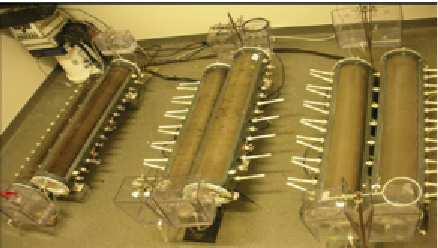Environmental Engineering Reference
In-Depth Information
under applied DCelectric field. The primary mechanism of interfacial ten-
sion reduction under applied electric field is reported as the reaction of
electrolysis products of brine/formation water (hydroxyl ions, OH
-
) on the
acid impurities of oil (carboxylic acids) (Fleureau and Dupeyart, 1988).
This results in formation and accumulation of low solubility surface-active
carboxylates analogous to that of directly adding a surfactant to reduce
the interfacial tension (Sato et al., 1998). The amount of interfacial tension
reduction is reported to be proportional to the applied potential (Tao and
Xu, 2006).
Interactions between the pore fluids and the solids, which are normally
affected by the ambient pH and redox conditions, will be enhanced upon
application of DC electric field. These electrochemically enhanced reac-
tions help oil transformation by cracking the heavy molecular structure
of crude oil into its lighter components with lower viscosity (Wittle at al.,
2007). As a result the functional group fractions of the crude oil, includ-
ing the
S
aturates,
A
romatics,
R
esins, and
A
sphaltenes (SARA) will be
affected. As the asphaltene and resin content of the formation oil decrease
and the aromatic content increases, it is expected that the viscosity of the
oil decrease. The less viscous the crude oil, the higher is its mobility in
the formation. Decrease in the oil viscosity under increased electric field
intensity has been reported in the literature (Sato et al., 1998; Tao and Xu,
2006; Wittle et al., 2008).
To investigate the oil transformation under applied DC electric field, a
series of synthetic cores were prepared and tested. Three of the test cells
were run at low current density of 0.1A/m
2
, three at high current den-
sity of 1.0 A/m
2
and three control cells at no current. The cells were 100
cm in length and 16.2 cm in diameter as shown in Figure 2.44. Titanium
Figure 2.44
Floor scale surrogate core test set-up
















Search WWH ::

Custom Search